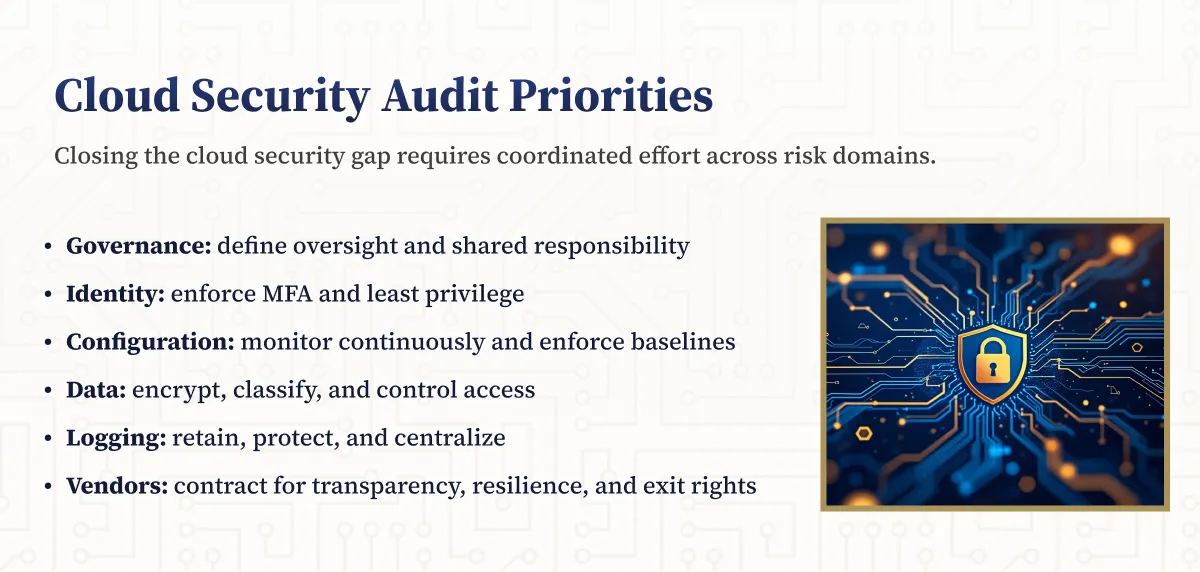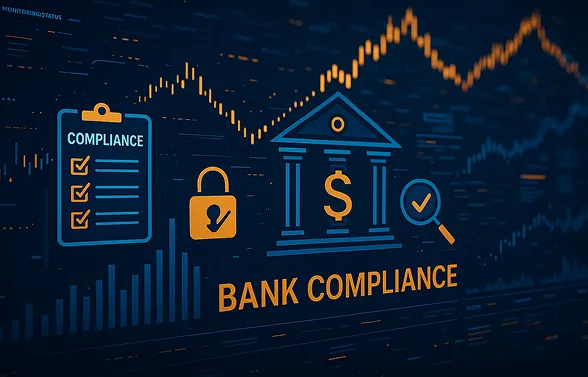In today's interconnected financial landscape, financial service providers face an ever-increasing risk of IT crises that can severely impact their operations, reputation, and bottom line. From cybersecurity breaches to system outages, the potential for digital disruption looms large. This guide explores the critical aspects of IT crisis management in financial services, offering insights and strategies to help financial institutions navigate through turbulent times.
Introduction to IT Crisis Management for Financial Institutions
IT crisis management in financial services refers to the structured approach financial institutions take to prepare for, respond to, and recover from significant technological disruptions. These disruptions can range from cyber attacks and data breaches to system failures and third-party service interruptions. A crisis management plan used in conjunction with cybersecurity assessments and audits, provides critical protection from outside threats.
.webp)
Understanding IT Crises: Types and Potential Impacts on Financial Institutions
IT crises in financial services can take various forms, each with its own set of challenges and potential consequences:
Cybersecurity Breaches
These include unauthorized access to systems, data theft, and ransomware attacks. The impact can be severe, involving financial losses, regulatory penalties, and reputational damage. Unauthorized access typically occurs through exploiting vulnerabilities such as weak passwords or unpatched software, allowing attackers to infiltrate systems and manipulate or steal sensitive data. Data theft involves cybercriminals exfiltrating confidential information, which can then be exploited for identity theft or sold illegally. Ransomware attacks, where data is encrypted and held hostage for a ransom, can paralyze business operations and force organizations to pay large sums to regain access to their systems, often without any guarantee of data recovery.
System Outages
Failures in core banking systems, online banking platforms, or payment processing systems can disrupt customer services and transactions, leading to financial losses and customer dissatisfaction. These outages often stem from issues such as software bugs, hardware failures, or cyberattacks that compromise system availability. When these critical systems go down, customers may be unable to access their accounts, complete transactions, or use essential banking services, causing significant inconvenience. Moreover, the financial implications can be substantial, including lost revenue from halted transactions and potential penalties from regulatory bodies for failing to meet service level agreements.
Data Loss or Corruption
Accidental or malicious destruction or alteration of critical data can compromise the integrity of financial records and customer information. Such data loss or corruption can occur due to various factors, including software errors, hardware malfunctions, cyberattacks, or even human error. When critical data is lost or altered, it can lead to inaccuracies in financial statements, transaction records, and customer account information, potentially causing significant operational and compliance issues. The integrity of financial data is crucial for making informed business decisions, ensuring regulatory compliance, and maintaining customer trust. Furthermore, recovering from data loss or corruption often requires extensive resources, including restoring backups, performing data reconstruction, and conducting thorough audits to verify data accuracy.
Third-Party Service Provider Failures
Financial Institutions increasingly rely on external vendors for critical services. Disruptions in these services can have cascading effects on a bank's operations. These third-party service provider errors may stem from issues such as technical failures, cyberattacks, or operational inefficiencies within the vendor's systems. When these disruptions occur, they can lead to delays or failures in essential services such as payment processing, IT infrastructure support, and customer service, directly impacting the bank's ability to serve its customers effectively. Moreover, reliance on external vendors increases the complexity of managing security and compliance, as the bank must ensure that these third parties adhere to stringent regulatory requirements and security standards.
Compliance Violations
IT issues that lead to non-compliance with regulatory requirements can result in severe penalties and increased scrutiny from regulatory bodies. These compliance violations may arise from inadequate data protection measures, failure to meet reporting obligations, or breaches of privacy laws, potentially triggering significant financial penalties. Beyond the immediate financial impact, non-compliance can also damage the institution's reputation, erode customer trust, and invite regulatory sanctions that may include operational restrictions or license revocations. In extreme cases, persistent non-compliance can threaten the overall stability of the financial system by undermining public confidence and triggering broader systemic risks.
Regulatory Requirements for IT Crisis Management in Financial Services
Financial institutions operate in a highly regulated environment, and IT crisis management is no exception. Key regulatory frameworks and guidelines include:
- The Federal Financial Institutions Examination Council (FFIEC) Information Technology Examination Handbook, which includes specific guidance on Business Continuity Management and Cybersecurity.
- The Basel Committee on Banking Supervision's Principles for Operational Resilience, which emphasize the importance of crisis management and business continuity.
- The Financial Stability Board (FSB) Effective Practices for Cyber Incident Response and Recovery, providing a toolkit for financial institutions to enhance their cyber incident response capabilities.
Financial Institutions must ensure that their IT crisis management plans align with these regulatory requirements to maintain compliance and operational resilience.
%201%20(1).svg)
%201.svg)
THE GOLD STANDARD INCybersecurity and Regulatory Compliance
Developing an IT Crisis Management Plan
A well-structured IT crisis management plan is the cornerstone of effective response and recovery. Key components of such a plan include:
- Risk Assessment and Scenario Planning: Identify potential IT crisis scenarios and assess their likelihood and potential impact.
- Response Strategies: Develop detailed response procedures for each type of crisis scenario.
- Communication Protocols: Establish clear communication channels and guidelines for internal and external stakeholders.
- Resource Allocation: Identify and allocate necessary resources, including personnel, technology, and financial reserves.
- Recovery and Continuity Procedures: Outline steps for restoring normal operations and maintaining critical functions during a crisis.
- Testing and Update Mechanisms: Implement regular testing and review processes to ensure the plan remains current and effective.

Forming and Training an Effective IT Crisis Management Team
A dedicated IT crisis management team is crucial for coordinating response efforts. This team should include:
- Senior executives with decision-making authority
- IT and cybersecurity specialists
- Legal and compliance experts
- Communications professionals
- Representatives from key business units
Regular training and crisis simulation exercises are essential to ensure the team can respond effectively under pressure.
Crisis Detection: Early Warning Systems and Monitoring
Timely detection of IT crises is critical for minimizing their impact. Financial Institutions should implement:
- Real-time monitoring of IT systems and networks
- Automated alert systems for anomalies and potential threats
- Integration with threat intelligence feeds
- Regular vulnerability assessments and penetration testing
Initial Response: Assessing the Situation and Activating the Crisis Plan
When a potential IT crisis is detected, the initial response should include:
- Rapid assessment of the situation to determine the nature and scope of the crisis
- Activation of the crisis management team
- Implementation of immediate containment measures
- Initial communication to relevant stakeholders
The speed and effectiveness of this initial response can significantly influence the overall outcome of the crisis.
Communication Strategies During an IT Crisis
Effective communication is paramount during an IT crisis. Financial Institutions must manage communications across multiple fronts:
- Internal Communication: Ensure clear, timely communication with employees to coordinate response efforts and maintain morale.
- Customer Communication: Provide transparent, accurate information to customers about the crisis and its potential impact on their accounts or services.
- Regulatory Reporting: Comply with all regulatory reporting requirements, providing timely and accurate information to relevant authorities.
- Media Relations: Manage media communications to control the narrative and protect the Financial Institution's reputation. Social media management is increasingly crucial during IT crises, requiring rapid response and careful message control to prevent the spread of misinformation.

Containment and Mitigation Strategies for Common IT Crises
Different types of IT crises require specific containment and mitigation strategies. For example:
- Cybersecurity breaches may require immediate isolation of affected systems, credential resets, and deployment of security patches.
- System outages might involve failover to backup systems and prioritization of critical services.
- Data loss scenarios could necessitate activation of data recovery procedures and validation of data integrity.
The NIST Special Publication 800-61: Computer Security Incident Handling Guide provides detailed guidance on containment and mitigation strategies for various IT security incidents.
Business Continuity and Operational Resilience During a Crisis
Maintaining critical business functions during an IT crisis is essential. Financial Institutions should:
- Implement robust business continuity plans aligned with the ISO 22301:2019 standard
- Establish clear procedures for activating alternate processing sites or cloud-based backup systems
- Prioritize critical business processes and customer services
- Conduct regular testing of business continuity plans to ensure their effectiveness
Cybersecurity Incident Response as Part of Crisis Management
Given the prevalence of cyber threats, Financial Institutions must integrate cybersecurity incident response into their overall crisis management framework. This includes:
- Establishing a dedicated Computer Security Incident Response Team (CSIRT)
- Implementing automated threat detection and response systems
- Conducting regular cybersecurity drills and simulations
- Maintaining relationships with law enforcement and cybersecurity agencies for coordinated response
Managing Reputational Risk During and After an IT Crisis
IT crises can significantly impact a Financial Institution’s reputation. To manage this risk:
- Develop pre-approved messaging templates for various crisis scenarios
- Train spokespersons to handle media inquiries effectively
- Monitor social media and online discussions to address misinformation quickly
- Implement a post-crisis communication strategy to rebuild trust
Post-Crisis Analysis and Lessons Learned
After the immediate crisis has been resolved, it's crucial to conduct a thorough post-mortem analysis. This should include:
- Detailed review of the crisis timeline and response actions
- Identification of areas for improvement in crisis management procedures
- Update of crisis management plans based on lessons learned
- Implementation of measures to prevent similar crises in the future
Testing and Simulating IT Crisis Scenarios
Regular testing and simulation of IT crisis scenarios are essential for maintaining readiness. Financial Institutions should:
- Conduct tabletop exercises to test decision-making processes
- Perform full-scale simulations of various crisis scenarios
- Include third-party service providers in crisis simulations where relevant
- Use the results of these exercises to refine and improve crisis management plans
Integrating IT Crisis Management with Enterprise Risk Management
IT crisis management should not operate in isolation but should be integrated into the Financial Institution’s overall enterprise risk management framework. This ensures alignment with broader organizational strategies and risk appetites.
Technology Solutions for IT Crisis Management
Various technology solutions can enhance IT crisis management capabilities:
- Crisis management software for coordinating response efforts
- Automated notification systems for rapid team activation
- Data analytics tools for real-time situation assessment
- Collaboration platforms for crisis team communication
NETBankAudit Helps Navigate the Complex Landscape of IT Risk and Crisis Management
NETBankAudit is a team of seasoned auditors and compliance consultants specializing in IT crisis and risk management for the financial services sector. With their deep industry knowledge and hands-on experience, NETBankAudit offers:
- IT risk assessments tailored to your institution's unique needs
- Development and review of IT crisis management plans
- Customized crisis simulation exercises and training programs
- Regulatory compliance guidance and audit support
- Post-crisis analysis and improvement recommendations

By leveraging NETBankAudit's expertise, Financial Institutions can significantly enhance their readiness to face IT crises, ensure regulatory compliance, and protect their operations and reputation in times of digital turmoil.
In an era where IT crises are not a matter of "if" but "when," partnering with NETBankAudit can provide the strategic advantage needed to navigate these challenges successfully and emerge stronger on the other side.
.avif)

.svg)

.webp)

.webp)











.webp)



.webp)

%201.webp)
.webp)
%20(3).webp)


.webp)


%20Works.webp)


.webp)




.webp)
%20(1).webp)

.webp)










.webp)
.webp)

.webp)
.webp)
.webp)
.webp)
.webp)
.webp)
%201.svg)